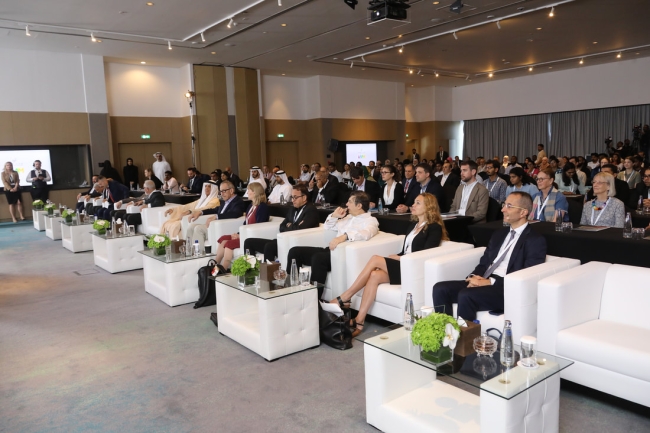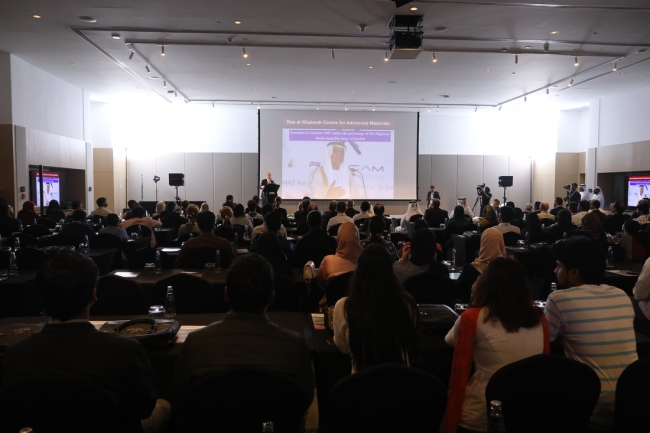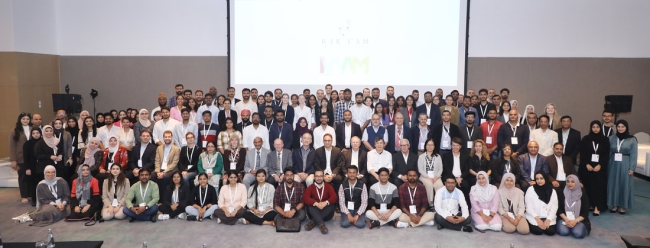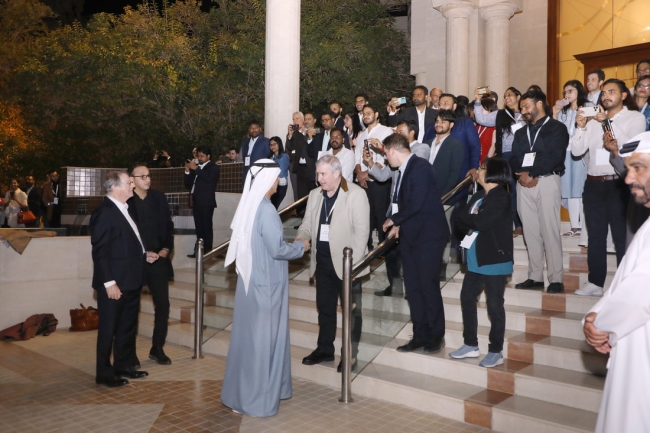9 minute read
Feature: Living in the material world – International Workshop on Advanced Materials
Ruari McCallion was one of the first international media representatives to be invited to attend the International Workshop on Advanced Materials (IWAM), the 14th edition of which was held in Ras Al-Khaimah, United Arab Emirates. Along with presentations on fundamental research, sessions covered developments in energy storage, water treatment, biofuels, the characteristics of graphene and carbon fibre, and the availability of a database of the property of tens of thousands of materials.
The highway from Dubai International Airport to the Emirate of Ras al-Khaimah (RAK) passes a large desalination plant near the border with Sharjah, which is in the process of being extended. The immediate and obvious product is fresh water; the need for it for the new offices, homes, hotels, leisure facilities and commercial buildings is obvious. Its byproduct is Sodium Chloride salt, the basis of chemical industries across the world and with the potential to be a key raw material in energy storage.
The 14th International Workshop on Advanced Materials (IWAM), 19-22 February, at the Movenpick Resort Hotel on the recently-created Marjan Island, RAK, was officially opened by Prof Anthony K Cheetham, FRS, Research Professor at the University of California, Santa Barbara, and of Cambridge University, the founding academic of IWAM. It brought together 201 participants from 17 countries, from theoretical scientists to practical engineers, with a seasoning of Nobel Prize winners, from universities and research institutes across the world.

Picture: IWAM Ras Al Khaimah
RAK is not blessed with the hydrocarbon deposits of its better-known neighbours. The Emirate’s ruler, His Highness Sheik Saud Bin Saqr Al Qasami, is keen that it should develop as a place for business and manufacturing, and as a centre of excellence for technology. His commitment was evident his passionate opening address to the conference.
A great deal was presented over the course of the three days of the Workshop proper. Too much for one article, in fact, so there will be others.
Material Advances – without reinventing the wheel
While some innovations and intellectual property (IP) are commercially sensitive, a huge amount is not and it is for the common good for information to be shared.
The Dresselhaus Memorial Lecture, named for one of the founders of IWAM and delivered by Kristin A. Persson, Distinguished Professor in Engineering at the University of California, Berkeley, was entitled ‘The Era of Data-Driven Materials Innovation and Design’. Professor Persson is a founder of The Materials Project, which uses supercomputing, advanced software and “quantum mechanical theory to compute the properties of all known inorganic materials [and]…design novel materials”. Data compiled in the Materials Project is offered free to the global scientific community – which is generous enough but there’s more: online analysis and design algorithms are available, too. Data currently available covers over 150,000 materials, along with millions of properties. Hardly surprising that it has proved to be very popular: it has over 300,000 registered users and is accessed 24/7/365.
“We calculate materials properties, which is in many cases orders of magnitude faster and cheaper than measuring them,” she said. The data is calculated using quantum mechanics and optimized workflows using high-performance computing resources.
“We take gold standard datasets from the community, from literature and from experiments, and our computed workflow automatically picks the right material based on given parameters. If you’re designing and making an aeroplane, for example, we would be able to provide ideas about which materials could sustain high stresses.” The Materials Project does not calculate composites, so carbon fibre would not be considered, for example.
In many applications, though, the Materials Project can cut years from projects. Duracell was helped to cut a new battery’s development time in half, for example.
“Automation is the great enabler. It saves all data, including failures – and failures are a crucial part of the learning process,” Prof Persson said.
Energy management
The biggest challenge for the most widely adopted alternative power sources – wind and solar – is energy management and storage, to enable power supply when the wind isn’t blowing and the sun isn’t shining, and storage when they are doing both and generating more than can be used.
Lithium-ion (Li-ion) technology is familiar and is at commercial scale but it uses materials that are expensive and increasingly hard to find. Other metals used in Li-ion batteries, such as cobalt, are expensive and relatively rare, and working conditions in some cobalt mines leave a lot to be desired. Reducing the need for new sources is a major chapllenge, as demand is set to continue to rise strongly.

Picture: IWAM Ras Al Khaimah
Li-ion: Second Life is a two-edged sword
Gerbrand Ceder, Samsung distinguished Professor in Engineering at the National Academy of Engineering, University of California, Berkeley, presented a session on Earth-Abundant and Inexpensive Li-ion Energy Storage.
The focus of his session was less about Lithium, however, and more about the use of Nickel and Cobalt (Ni and Co), the other two main components. A new and emerging technology uses disordered rocksalt cathodes (DRX), which can be synthesised with any metal – thus reducing or even eliminating dependence on Ni and Co.
DRX technology means that Titanium (Ti) and Manganese (Mn), which are cheaper and more plentiful than Ni and Co, can be used in their stead. The industry has been striving to reduce disorder but it is that characteristic that makes Ti and Mn cathodes work. It also reduces oxygen release. As future Ni and Co supplies are becoming restricted by countries like Indonesia, which want to grow their indigenous battery industries, alternative supplies become critical.
Energy management: introducing Na-ion
While renewable energy generation, such as wind and solar power, are gaining share seemingly by leaps and bounds, their problem is that they don’t work when the wind isn’t blowing and the sun isn’t shining – a particular issue in higher latitudes, such as in the UK. At other times, the wind – especially – can blow rather hard; so hard, in fact, that turbines have to be switched off and disconnected from the Grid, to stop it being overloaded. If the industry is not to follow the destructive route of building fossil fuel surge capacity to meet energy needs when the sun isn’t shining and the wind isn’t blowing, it must design and deliver systems at commercial scale that can harvest and store excess production, and release it when needed.
The emerging technology, which shows a lot of promise, uses Sodium ion (Na-ion), rather than Lithium. It is abundant in the oceans and every large body of water, across the world. The salt deposits in Cheshire and Teesside remain viable today. Desalination plants, such as those found in the UAE, make salt as a by-product.
“Sodium ions are bigger than Li-ion, which means that Na-ion battery cells will be lower voltage and heavier than Li-ion,” said Dr Raphaele J Clement, Assistant Professor, Materials Department, University of California, Santa Barbara. Demand for transition metals is forecast to reach around seven million tonnes a year by 2060; Li-ion on its own cannot supply the need on its own.
“Na-ion batteries offer possibilities for renewable energy management,” she said. Stationary, large Na-ion plants, on the beach near offshore wind farms, could store excess energy generated at off-peak and extra windy times, and harvest solar energy during the day for use at night.
Dr Pieremanuele Canepa, Assistant Professor, Materials Science and Engineering, National University of Singapore agreed on the potential for grid applications. He said there are a few companies around the world that are investing in research and development. Faradion, based in Sheffield, UK, recently delivered and installed a battery pack to a trial site in the Yarra Valley, New South Wales, Australia, and a company called AceOn was recently awarded a £1 million grant by Innovate UK to accelerate development work on its mobile solar energy storage unit in its projects in sub-Saharan Africa.
Na-ion batteries are lighter and more energy-dense than lead-acid, so could also have a role in large-scale transport, such as trains and ships, and in uninterruptible power supply (UPS) systems for hospitals, banks and Cloud servers.

Picture: IWAM Ras Al Khaimah
Additive manufacturing: tweaking the recipe
Cricketing enthusiast and mechanical engineer Professor Upadastra ‘Ram’ Ramamurty, President’s Chair in Mechanical and Aerospace Engineering and Materials Science and Engineering at Nanyang Technological University’s School of Mechanical & Aerospace Engineering in Singapore, has spent the last six years looking at additive manufacturing (AM); specifically, 3D printed metals.
New technology can look very attractive but it has to prove itself and proponents have to be sure they are not over-promising. It is not a magic bullet.
One of the potentially greatest advantages of AM is that it can be used to ‘tune’ alloy characteristics to more closely meet end use needs. An example cited by Prof Ramamurty during his presentation was of Fe-Co (iron-cobalt) alloys.
“A 50/50 iron/cobalt alloy gives the best soft magnetic qualities but, when they go through conventional manufacturing, there is a brittle phase,” he explained. During that phase, they are impossible to machine – even the minutest machining will shatter it. Maraging steels – martensitic ageing steels – possess superior strength and toughness, while maintaining ductility. They are used for rocket casings but they are frighteningly expensive. There has been a long quest to find an alternative to cobalt that offers the same properties in alloy but is a lot cheaper. The hurdle is inherent tensile strength. Aluminium, for example, possesses 70 GigaPascals; steel has 200 and titanium has 110.
“These are not variable. The elastic modulus is fundamentally about the bonding characteristics at an atomic level. What we can change is microstructure; we can play around with the strength and toughness combination in AM, in 3D printing,” he continued. “Usually, if strength is increased then toughness goes down, and the other way around. Certain intrinsic features of 3D printing allow us to impart a particular kind of structure, so that we can get both of these properties. That is what we have been doing in the laboratories.”
Industries like construction and nuclear power are inherently conservative – and with good reason; failure can be catastrophic. If you lose your phone or its battery fails, it is inconvenient. If structural components in buildings or nuclear power plants fail then lives can be lost. What Prof Ramamurty and his colleagues are doing is developing alloys that can help to reduce cost and can be 3D printed without losing the characteristics that made the established compounds accepted.

Picture: IWAM Ras Al Khaimah
Other presentations: water purification, solar power
A team headed by Mahmoud Khedher from the STEM School at the University of South Australia, Adelaide, Australia, presented the results of a project that used reprocessed drinking water sludge for organics removal, disinfection and interdiction of byproduct formation.
Mehreen Javed presented on the use of ‘green’ energy materials and improved efficiency in pv (photovoltaic) applications, which are forecast to provide up to 50% of energy by 2060.
Professor Andrew B Holmes, Melbourne Laureate Professor Emeritus, University of Melbourne, Australia, gave a presentation on Progress in Thin Film Organic and Perovskite Solar Cells. Perovskite materials are cheap to produce and simple to manufacture. Prof Holmes described the latest developments, including improved stability and advances in efficiencies of over 20%, in laboratory conditions.
Prof Tony Cheetham, founder of IWAM, continued the perovskite theme with a presentation that covered carbon capture technologies.
A taste of the future
Over 100 projects on a range of topics were presented in poster form in two sessions. A full list and descriptions can be found at Poster Sessions.
The final morning was given over to competitive presentations by local schools and further education colleges, sponsored by the University of Bolton Ras Al Khaimah campus. Those selected will form part of the supporting exhibition at COP28, to be held in the UAE later in 2023.
The International Workshop on Advanced Materials has had a low profile hitherto but the work being presented at it is rather important, right now and for developments in the future. Session recordings will be available on the IWAM YouTube channel in due course.